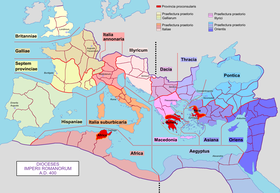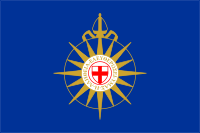Diocese

Diocese of Linköping, Söderköpings kommun, Sweden

A diocese is the district or see under the supervision of a bishop. It is divided into parishes.
An archdiocese is more significant than a diocese. An archdiocese is presided over by an archbishop whose see may have or had importance due to size or historical significance. The archbishop may have metropolitan authority over any other (then 'suffragan') bishops and their dioceses within his ecclesiastical province.
This structure of church governance is known as episcopal polity.
A diocese also may be referred to as a bishopric or episcopal see, though strictly the term episcopal see refers to the domain of ecclesiastical authority officially held by the bishop, and the term bishopric to the post of being bishop.
- The bishops, Greek: Episkopos, elders or overseers, of the long-established churches claim Apostolic succession, a direct historical lineage dating back to the original Twelve Apostles.
- The word diocese is from the Greek term διοίκησις, meaning "administration".
Catholic Church
As of January 2009[update] there are 630 Catholic archdioceses (including 13 patriarchates, two catholicates, 536 metropolitan archdioceses, 79 single archdioceses) and 2,167 dioceses in the world.
Eastern Catholic churches
In the Eastern Catholic Churches (which recognize papal authority and are a part of the larger Catholic Church), the equivalent unit is called an eparchy.

Cathedral of the Diocese of Armagh and Metropolitan Cathedral of the United Provinces of Armagh and Tuam,
Church of Ireland
Anglican Communion
Eastern Orthodox Church
The Eastern Orthodox Church calls dioceses metropoleis in the Greek tradition or eparchies in the Slavic tradition.
Church of England and Anglican Communion
After the Reformation, the Church of England retained the existing diocesan structure which remains throughout the Anglican Communion.
Lutheranism
Poland, Germany, Denmark, Norway, Iceland, Sweden, Finland
Certain Lutheran denominations such as the Church of Sweden do have individual dioceses similar to Roman Catholics. These dioceses and archdioceses are under the government of a bishop (see Archbishop of Uppsala).[1] Other Lutheran bodies and synods that have dioceses and bishops include the Church of Denmark, the Evangelical Lutheran Church of Finland, the Evangelical Church in Germany (partially), and the Church of Norway.[2]
Lutheranism in USA
Some American Lutheran synods such as the Evangelical Lutheran Church in America do have a bishop acting as the head of the synod,[3] but the synod does not have dioceses and archdioceses as the churches listed above. Rather, it is divided into a middle judicatory.[4] The Lutheran Church-International, based in Springfield, Illinois, presently uses a traditional diocesan structure, with four dioceses in North America. Its current president is Archbishop Robert W. Hotes.[5]
Churches that have neither dioceses nor bishops
Methodism
In the British Methodist Church and Irish Methodist Church, churches are grouped together in sections. Sections are grouped together to form Circuits. Circuits are grouped together to form Districts. All of these, combined with the local membership of the Church, are referred to as the 'Connexion'. This 18th-century term, endorsed by John Wesley who remained within the Church of England, describes how people serving in different geographical centres are 'connected' to each other. The Methodist Church has an annual president. Each District is headed by a 'Chair' who oversees its functioning. Each Circuit is governed by a superintendent minister. The geographical regions covered by circuits and dioceses rarely overlap.
In the United Methodist Church (the United States and some other countries), a bishop is given oversight over a geographical area called an Episcopal Area. Each episcopal area contains one or more annual conferences, which is how the churches and clergy under the bishop's supervision are organized. Thus, the use of the term "diocese" referring to geography is the most equivalent in the United Methodist Church, whereas each annual conference is part of one episcopal area (though that area may contain more than one conference). The African Methodist Episcopal Church has a similar structure to the United Methodist Church, also using the Episcopal Area.
Baptists
Most Baptists hold that no church or ecclesiastical organization has inherent authority over a Baptist church. Churches can properly relate to each other under this polity only through voluntary cooperation, never by any sort of coercion. Furthermore, this Baptist polity calls for freedom from governmental control.[6] Most Baptists believe in "Two offices of the church"—pastor-elder and deacon—based on certain scriptures (1 Timothy 3:1–13; Titus 1–2).
Exceptions to this local form of local governance include a few churches that submit to the leadership of a body of elders, as well as the Episcopal Baptists that have an Episcopal system.
History

of the Roman Empire
400 AD
In the later organization of the Roman Empire, the increasingly subdivided provinces were administratively associated in a larger unit, the diocese (Latin dioecesis, from the Greek term διοίκησις, meaning "administration").
With the adoption of Christianity as the Empire's official religion in the 4th century, the clergy assumed official positions of authority alongside the civil governors. A formal church hierarchy was set up, parallel to the civil administration, whose areas of responsibility often coincided.
With the collapse of the Western Empire in the 5th century, the bishops in Western Europe assumed a large part of the role of the former Roman governors. A similar, though less pronounced, development occurred in the East, where the Roman administrative apparatus was largely retained by the Byzantine Empire. In modern times, many diocese, though later subdivided, have preserved the boundaries of a long-vanished Roman administrative division. For Gaul, Bruce Eagles has observed that "it has long been an academic commonplace in France that the medieval dioceses, and their constituent pagi, were the direct territorial successors of the Roman civitates.[7]
Modern usage of 'diocese' tends to refer to the sphere of a bishop's jurisdiction. This became commonplace during the self-conscious "classicizing" structural evolution of the Carolingian empire in the 9th century, but this usage had itself been evolving from the much earlier parochia ("parish"), dating from the increasingly formalised Christian authority structure in the 4th century (see EB 1911).
See also
- List of Eastern Orthodox dioceses and archdioceses
- List of Anglican dioceses
- List of Anglican Church of Canada dioceses
- List of Church of England dioceses
- List of Church of Ireland dioceses
- Dioceses of the Episcopal Church in the United States of America
- List of Lutheran dioceses and archdioceses
- List of the dioceses of the Orthodox Church in America
- List of Roman Catholic archdioceses
- List of Roman Catholic dioceses
- List of the Roman Catholic dioceses of the United States
- Eparchy, a term in Eastern Catholicism, Eastern Orthodoxy, Oriental Orthodoxy, and the Assyrian Church of the East
- List of Bishops
- Notitia dignitatum
- Particular Church
- Ecclesiastical Latin
- Catholic Church in Great Britain
- Structure of the Church of England
- Global organisation of the Roman Catholic Church
Notes
- ^ Adam of Bremen, Gesta Hammaburgensis ecclesiae pontificum, online text in Latin; scholia 94.
- ^ see List of Lutheran dioceses and archdioceses.
- ^ Office of the Presiding Bishop on ELCA.org. Retrieved 2010-16-04.
- ^ LERNing newsletter from July 2005 at ELCA.org. Retrieved 2010-16-04.
- ^ [1]
- ^ Pinson, William M., Jr. "Trends in Baptist Polity". Baptist History and Heritage Society.
{{cite journal}}: Cite journal requires|journal=(help)CS1 maint: multiple names: authors list (link) - ^ Bruce Eagles, "Britons and Saxons on the Eastern Boundary of the Civitas Durotrigum" Britannia 35 (2004:234–240) p 234, noting for instance E.M. Wightman, Gallia Belgica (London) 1985:26.
Sources and external links
- Definition from 1911 Britannica
- Complete list of Catholic dioceses worldwide by Giga-Catholic Information
- Virtually complete list of current and historical Catholic dioceses worldwide
- Another such list, in English and Norwegian
- List of current Anglican/Episcopalian dioceses
 Herbermann, Charles, ed. (1913). "Diocese". Catholic Encyclopedia. New York: Robert Appleton Company.
Herbermann, Charles, ed. (1913). "Diocese". Catholic Encyclopedia. New York: Robert Appleton Company.- Indian Orthodox Church Diocese Portal
- Coats of Bishops and of Dioceses


